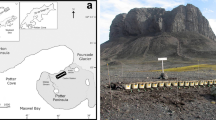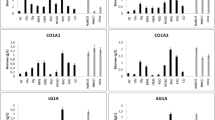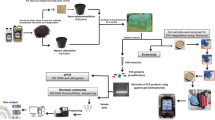Abstract
Several studies have shown that biostimulation can promote hydrocarbon bioremediation processes in Antarctic soils. However, the effect of the different nutrient sources on hydrocarbon removal heavily depends on the nutrients used and the soil characteristics. In this work, using a sample of chronically contaminated Antarctic soil that was exposed to a fresh hydrocarbon contamination, we analyzed how a complex organic nutrient source such as fish meal (FM) and a commercial fertilizer (OSEII) can affect hydrocarbon biodegradation and bacterial community composition. Both amended and unamended (control) biopiles were constructed and controlled at Carlini Station and sampled at days 0, 5, 16, 30 and 50 for microbiological, chemical and molecular analyses. FM caused a fast increase in both total heterotrophic and hydrocarbon degrading bacterial counts. These high values were maintained until the end of the assay, when statistically significant total hydrocarbon removal (71 %) was detected when compared with a control system. The FM biopile evidenced the dominance of members of the phylum Proteobacteria and a clear shift in bacterial structure at the final stage of the assay, when an increase of Actinobacteria was observed. The biopile containing the commercial fertilizer evidenced a hydrocarbon removal activity that was not statistically significant when compared with the untreated system and exhibited a bacterial community that differed from those observed in the unamended and FM-amended biopiles. In summary, biostimulation using FM in biopiles significantly enhanced the natural hydrocarbon-degradation activity of the Carlini station soils in biopile systems and caused significant changes in the bacterial community structure. The results will be considered for the future design of soil bioremediation protocols for Carlini Station and could also be taken into account to deal with diesel-contaminated soils from other cold-climate areas.





Similar content being viewed by others
References
Adetutu EM, Bird C, Kadali KK, Bueti A, Shahsavari E, Taha M, Patil S, Sheppard PJ, Makadia T, Simons KL, Ball AS (2014) Exploiting the intrinsic hydrocarbon-degrading microbial capacities in oil tank bottom sludge and waste soil for sludge bioremediation. Int J Environ Sci Technol 1–10. doi:10.1007/s13762-014-0534-y
Ahn JH, Kim MS, Kim MC, Lim JS, Lee GT, Yun JK, Kim T, Ka JO (2006) Analysis of bacterial diversity and community structure in forest soils contaminated with fuel hydrocarbon. J Microbiol Biotechnol 16:704–715
Aislabie JM, Balks MR, Foght JM, Waterhouse EJ (2004) Hydrocarbon spills on Antarctic soils: effects and management. Environ Sci Technol 38:1265–1274
Aislabie J, Saul D, Foght J (2006) Bioremediation of hydrocarbon-contaminated polar soils. Extremophiles 10:171–179
Aislabie JM, Novis PM, Ferrari B (2014) Microbiology of eutrophic (ornithogenic and hydrocarbon-contaminated) soil. In: Cowan DA (ed) Antarctic terrestrial microbiology. Springer, Berlin, pp 91–113
ATCM XXXV (2012) Environmental issues related to the practicality of repair or remediation of environmental damage. Working paper 026 presented to ATCM XXXV, Hobart, New Zealand
ATCM XXXVI (2013) Repair or remediation of environmental damage: report of the CEP intercessional contact group. Working paper 027 presented to ATCM XXXVI, Bruseles, Belgium
Baek K-H, Byung-Dae Y, Byung-Hyuk K, Dae-Hyun C, In-Sook L, Hee-Mock O, Hee-Sik K (2007) Monitoring of microbial diversity and activity during bioremediation of crude oil-contaminated soil with different treatments. J Microbiol Biotechnol 17:67–73
Bell TH, Yergeau E, Martineau C, Juck D, Whyte LG, Greer CW (2011) Identification of nitrogen-incorporating bacteria in petroleum-contaminated Arctic soils by using [15N]DNA-based stable isotope probing and pyrosequencing. Appl Environ Microbiol 77:4163–4171
Bell TH, Yergeau E, Maynard C, Juck D, Whyte LG, Greer CW (2013) Predictable bacterial composition and hydrocarbon degradation in Arctic soils following diesel and nutrient disturbance. ISME J 7:1200–1210
Björklöf K, Salminen J, Sainio P, Jørgensen K (2008) Degradation rates of aged petroleum hydrocarbons are likely to be mass transfer dependent in the field. Environ Geochem Health 30:101–107
Braddock JF, Ruth ML, Catterall PH, Walworth JL, McCarthynd KA (1997) Enhancement and inhibition of microbial activity in hydrocarbon-contaminated arctic soils: implications for nutrient-amended bioremediation. Environ Sci Technol 31:2078–2084
Bray RH, Kurtz LK (1945) Determination of total organic and available forms of phosphorus in soil. Soil Sci 591:39–45
Chemlal R, Tassist A, Drouiche M, Lounici H, Drouiche N, Mameri N (2012) Microbiological aspects study of bioremediation of diesel-contaminated soils by biopile technique. Intl Biodeterior Biodegradation 75:201–206
Cole JR, Wang Q, Cardenas E, Fish J, Chai B, Farris RJ, Kulam-Syed-Mohideen AS, McGarrell DM, Marsh T, Garrity GM, Tiedje JM (2009) The Ribosomal Database Project: improved alignments and new tools for rRNA analysis. Nucleic Acids Res 37:141–145
Del Panno MT, Morelli I, Engelen B, Berthe-Corti L (2005) Effect of petrochemical sludge concentrations on microbial communities during a soil bioremediation process. FEMS Microbiol Ecol 53:305–316
Delille D (2000) Response of Antarctic soil bacterial assemblages to contamination by diesel fuel and crude oil. Microb Ecol 40:159–168
Delille D, Duval A, Pelletier E (2008) Highly efficient pilot biopiles for on-site fertilization treatment of diesel oil-contaminated sub-Antarctic soil. Cold Reg Sci Technol 54:7–18
Delille D, Pelletier E, Rodriguez-Blanco A, Ghiglione J-F (2009) Effects of nutrient and temperature on degradation of petroleum hydrocarbons in sub-Antarctic coastal seawater. Polar Biol 32:1521–1528
Dias RL, Ruberto LAM, Vázquez SC, Hernández E, Lo Balbo A, Del Panno MT, Mac Cormack WP (2012) Bioremediation of an aged diesel oil-contaminated Antarctic soil: evaluation of the “on site” biostimulation strategy using different nutrient sources. Int Biodeterior Biodegradation 75:96–103
Espeche ME, Mac Cormack WP, Fraile ER (1994) Factors affecting growth of an n-hexadecane degrader Acinetobacter species isolated from a highly polluted urban river. Int Biodeterior Biodegradation 33:187–196
Ferguson SH, Franzmann PD, Revill AT, Snape I, Rayner JL (2003) The effects of nitrogen and water on mineralisation of hydrocarbons in diesel-contaminated terrestrial Antarctic soils. Cold Reg Sci Technol 37:197–212
Gee GW, Bauder JW (1986) Particle-size analysis. In: Klute A, Madison WI (eds) Methods of soil analysis, Part 1. Physical and mineralogical methods. Agronomy Monograph No. 9, 2nd edn. Soil Science Society of America, Madison, pp 383–411
Greer CW (2009) Bioremediation of contaminated sites in the Canadian Arctic: monitoring performance and the effects of biostimulation using molecular methods. In: Bej A, Aislabie J, Atlas RM (eds) Polar microbiology: the ecology, diversity and bioremediation potential of microorganisms in extremely cold environments. Taylor and Francis CRC Press, Boca Raton, pp 321–340
Greer CW, Whyte L, Neiderberger TD (2010) Microbial communities in hydrocarbon-contaminated temperate, arid, tropical, alpine, and polar soils. In: Timmis KN (ed) Polar microbiology: the ecology, diversity and bioremediation potential of microorgansims in extremely cold environments. Handbook of hydrocarbon and lipid microbiology. Springer, Berlin, pp 2313–2328
Hamzah A, Salleh SNMd, Lee SL, Sarmani S (2012) Bioaugmentation of microbial consortia and supplementation of bulking agents in removal of crude oil from soil. In: Mendez-Vilas A (ed) Microbes in applied research. Current advances and challenges. World Scientific Publishing Co, London, pp 39–43
Helmke E, Gerdes B, Juergens J, Reuter K (2013) Bioremediation method for accelerated biological decomposition of petroleum hydrocarbons in sea ice-covered polar regions, and bacteria and enzyme mixtures as agents for carrying out said method. US patent 2013/0210112 A1, issued Aug 15, 2013
Jin HM, Choi EJ, Jeon CO (2013) Isolation of a BTEX-degrading bacterium, Janibacter sp. SB2, from a sea-tidal flat and optimization of biodegradation conditions. Bioresour Technol 145:57–64
Jørgensen KS, Puustinen J, Suortt AM (2000) Bioremediation of petroleum hydrocarbon-contaminated soil by composting in biopiles. Environ Pollut 107:245–254
Kang YS, Park W (2010) Protection against diesel oil toxicity by sodium chloride-induced exopolysaccharides in Acinetobacter sp. strain DR1. J Biosci Bioeng 109:118–123
Kauppi S, Sinkkonen A, Romantschuk M (2011) Enhancing bioremediation of diesel-fuel-contaminated soil in a boreal climate: comparison of biostimulation and bioaugmentation. Int Biodeterior Biodegradation 65:359–368
Lee K, Tremblay GH, Cobanli SE (1995) Bioremediation of oiled beach sediments. Assessment of inorganic and organic fertilizers, evolving technologies. In: Proceedings 1995 int oil spill conference, American Petroleum Institute, Washington DC, pp 107–112
Mac Cormack WP, Ruberto LAM, Curtosi A, Vodopivez C, Pelletier E (2011) Human impacts in the Antarctic coastal zones: the case study of hydrocarbons contamination at Potter Cove, South Shetland Islands. In: Coffen-Smout S (ed) Ocean year book, vol 25. Brill/Martinus Nijhoff, Dalhousie University, Nova Scotia, pp 141–170
Margesin R, Labbe D, Schinner F, Greer CW, Whyte LG (2003) Characterization of hydrocarbon-degrading microbial populations in contaminated and pristine alpine soils. Appl Environ Microbiol 69:3085–3092
Muyzer G, Brinkhoff T, Nübel U, Santegoeds C, Schäfer H, Waver C (1998) Denaturing gradient gel electrophoresis (DGGE) in microbial ecology. In: Akkermans ADL, van Elsas JD, de Bruijn FJ (eds) Molecular microbial ecology manual. Kluwer Academic, Dordrecht, pp 1–27
Pearson K (1926) On the coefficient of ratial likeness. Biometrika 18:105–117
Pelletier E, Delille D, Delille B (2004) Crude oil bioremediation in sub-Antarctic intertidal sediments: chemistry and toxicity of oiled residues. Mar Environ Res 57:311–327
Popp M, Schlömann M, Mau M (2006) Bacterial diversity in the active stage of a bioremediation system for mineral oil hydrocarbon-contaminated soils. Microbiol 152:3291–3304
Ruberto LAM, Vázquez SC, Mac Cormack WP (2003) Effectiveness of the natural bacterial flora, biostimulation and bioaugmentation on the bioremediation of a hydrocarbon contaminated Antarctic soil. Int Biodeterior Biodegradation 52:115–125
Ruberto LAM, Vázquez SC, Mac Cormack WP (2008) Bacteriology of extremely cold soils exposed to hydrocarbon pollution. In: Dion P, Nautiyal CS (eds) Microbiology of extreme soils. Soil biology series 13, chapter 12. Springer, Berlin, pp 247–274
Ruberto LAM, Dias R, Lobalbo A, Vázquez SC, Hernández EA, Mac Cormack WP (2009) Influence of nutrients addition and bioaugmentation on the hydrocarbon biodegradation of a chronically contaminated Antarctic soil. J Appl Microbiol 106:1101–1110
Sanscartier D, Zeeb B, Koch I, Reimer K (2009) Bioremediation of diesel-contaminated soil by heated and humidified biopile system in cold climates. Cold Reg Sci Technol 55:167–173
Saul DJ, Aislabie J, Brown CE, Harris L, Foght JM (2005) Hydrocarbon contamination changes the bacterial diversity of soil from around Scott Base, Antarctica. FEMS Microbiol Ecol 53:141–155
Shrestha PM, Noll M, Liesack W (2007) Phylogenetic identity, growth–response time and rRNA operon copy number of soil bacteria indicate different stages of community succession. Environ Microbiol 9:2464–2474
Snape I, Ferguson SH, Harvey PMA, Riddle MJ (2006) Investigation of evaporation and biodegradation of fuel spills in Antarctica: II. Extent of natural attenuation at Casey Station. Chemosphere 63:89–98
Stallwood B, Shears J, Williams PA, Hughes KA (2005) Low temperature bioremediation of oil-contaminated soil using biostimulation and bioaugmentation with a Pseudomonas sp. from maritime Antarctica. J Appl Microbiol 99:794–802
Stillman NW (1992) Bioremediation yeast and surfactant composition. U.S. patent 5160488 A. Filed September 14, 1990, and issued Nov 3, 1992
Vester J, Glaring M, Stougaard P (2014) Discovery of novel enzymes with industrial potential from a cold and alkaline environment by a combination of functional metagenomics and culturing. Microb Cell Fact 13:72
Walkley A, Black IA (1934) An examination of the Degtjareff method for determining organic carbon in soils: effect of variations in digestion conditions and of inorganic soil constituents. Soil Sci 63:251–263
Whyte LG, Schultz A, Van Beilen JB (2002) Prevalence of alkane monooxygenase genes in Arctic and Antarctic hydrocarbon-contaminated and pristine soils. FEMS Microbiol Ecol 41:141–150
Wynn-Williams DD (1992) Counting bacterial colony-forming units in soil. In: Wynn-Williams DD (ed) BIOTAS manual of methods for Antarctic terrestrial and freshwater research, section II. Scientific Committee on Antarctic Research, Cambridge, p 3
Yergeau E, Arbour M, Brousseau R, Juck D, Lawrence JR, Masson L, Whyte LG, Greer CW (2009) Microarray and real-time PCR analyses of the responses of high Arctic soil bacteria to hydrocarbon pollution and bioremediation treatments. Appl Environ Microbiol 75:6258–6267
Yergeau E, Sanschagrin S, Beaumier D, Greer CW (2012) Metagenomic analysis of the bioremediation of diesel-contaminated Canadian high Arctic soils. PLoS One 7:1–10
Zhu X, Venosa AD, Suidan MT (2004) Literature review on the use of commercial bioremediation agents for cleanup of oil-contaminated estuarine environments. EPA/600/R-04/075 July 2004
Zwick TC, Foote EA, Pollack AJ, Boone JL, Alleman BC, Hoeppel RE, Bowling L (1997) Effects of nutrient addition during bioventing of fuel contaminated soils in an arid environment. In: Alleman BC, Leeson A (eds) In-situ and on-site bioremediation, vol 1. Battelle Press, Columbus, pp 403–409
Acknowledgments
We acknowledge the financial support of this research by the Agencia Nacional de Promoción Científica y Tecnológica (PICTO No. 0124) and the Facultad de Farmacia y Bioquímica, Universidad de Buenos Aires (UBACyT 20,020,100,100,378). We also had financial support from the European Commission through the Marie Curie Action IRSES, project no. 318718, IMCONet (Interdisciplinary Modeling of Climate Change in Coastal Western Antarctica-Network for Staff Exchange and Training). In addition, we acknowledge Cecilia Ferreiro for her professional help with the English in the manuscript.
Author information
Authors and Affiliations
Corresponding author
Rights and permissions
About this article
Cite this article
Dias, R.L., Ruberto, L., Calabró, A. et al. Hydrocarbon removal and bacterial community structure in on-site biostimulated biopile systems designed for bioremediation of diesel-contaminated Antarctic soil. Polar Biol 38, 677–687 (2015). https://doi.org/10.1007/s00300-014-1630-7
Received:
Revised:
Accepted:
Published:
Issue Date:
DOI: https://doi.org/10.1007/s00300-014-1630-7




